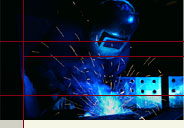
The front rotors or discs from a 350ZX Track model can be used on the 300ZX (z32), along with adapters for reusing the stock 300ZX calipers. The stock 300ZX rotors are 10.8 inches in diameter. The 350ZX Track rotors, made by Brembo, are 12.75 inches. The front wheels need to be at least 17 inches (minimum 385 millimeters inside diameter) in order for the larger rotors to fit, so the stock 16 inch wheels are not big enough.
The only z32 brake calipers with which this kit will NOT work are the early 1990, non-turbo 26 millimeter aluminum calipers. All the rest of the z32 calipers are 30 millimeters, and will match up fine. The caliper material was changed from aluminum to iron half way through 1992. The big brake upgrade kit works with both aluminum and iron calipers.
I bought the larger rotors, adapters, and mounting hardware from a company that subsequently went out of business. I bought my kit from a second vendor who is also not carrying the adapters anymore. If any reader knows of someone who is selling these adapters, please E-mail me.
Here is a pic showing the two aluminum caliper adapters on either side of a 350Z Track rotor or disc. The adapters move the stock calipers further from the hub so that they can fit around the new, larger rotor.
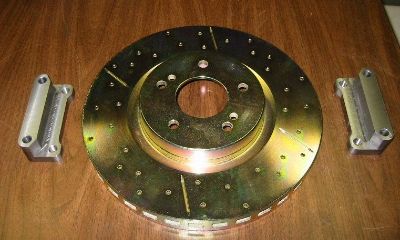 The bronze color of the disc was cadmium coating. The brake pads rub the cadmium off in the first few minutes of braking. The bronze color of the disc was cadmium coating. The brake pads rub the cadmium off in the first few minutes of braking.
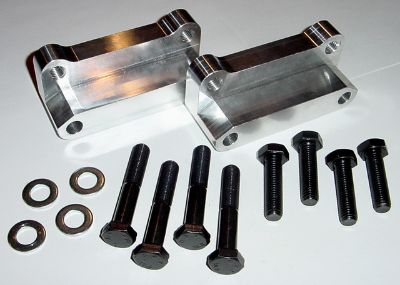 Here is a close-up of the new adapters and hardware that Bernie sells. Here is a close-up of the new adapters and hardware that Bernie sells.
Upgrading to larger front rotors and reusing the original calipers with the above adapters is probably the cheapest way to get a true big brake upgrade. Buying an entire aftermarket big brake replacement kit, including rotors and calipers, can easily cost three to five times as much as this kit. I like to call this mod the "best big brake bang for the buck" (nice alliteration, lol).
The theory behind using a larger rotor is mainly based on the simple physics of work = force X distance. Technically, to solve for the forces on the rotor during braking requires calculus and formulas for angular momentum of a rotational mass, but for purposes of simplification, these can be left out of our discussion.
The same work done by the calipers at a further distance from the center of the wheel will apply more stopping torque at the hubs. Another way to put it is that the calipers don't have to work as hard on the bigger discs. This assumes all other factors to be equal, such as the types of brake lines, brake pads, brake fluid, tires, road conditions, brake pedal pressure, etc.
Heat is the enemy of all brakes. The disc surface area covered by a single rotation through the calipers is greater on a larger disc. The bigger disc is a larger heat sink that should dissipate excess heat more efficiently than a smaller disc. This allows the brakes to perform more stops before heat builds up and causes brake fading.
Whether or not the car stops quicker or in shorter distances is debatable, since the limiting factor to that probably has more to do with the contact patch of the tire and the friction coefficient between the tire and the road. I believe the main advantage of this big brake kit is less brake fade during repeated hard stops, such as when racing around a road course, or doing spirited driving through a favorite stretch of twisties.
Certainly a car takes longer to stop if the brakes have noticably faded underfoot. Anyone who has experienced significant brake fade due to heat build up will remember that awful and helpless feeling. The right foot presses on the brake pedal harder and harder, but the car keeps going. The assumption here will be that installing a larger disc or rotor is a bonafide upgrade.
Here is my old Brembo drilled rotor on the left, and the new slotted 350X Track rotor on the right. In fact, Brembo makes both rotors, but the one on the right is OEM for the Nissan 350Z Track model. The difference between drilled and slotted is also debatable. I asked the vendor to send me the style he recommended, and I got slotted. I guess that's better than getting drilled, lol.
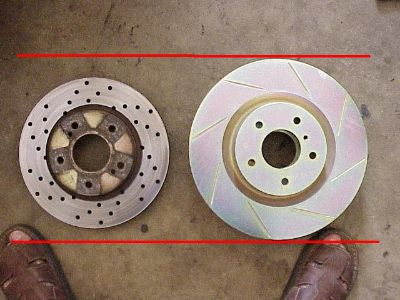
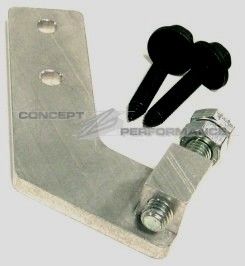 While my rotors were being installed by Z guru Bernie, I put in a master cylinder brace that I bought from Concept Z Performance. Coz is a good man with whom to deal. While my rotors were being installed by Z guru Bernie, I put in a master cylinder brace that I bought from Concept Z Performance. Coz is a good man with whom to deal.
The principle behind this brace is sound. The body of the brace is shown by the blue X below. The brace is flipped over compared to the photo above. The brace is mounted under the fuel filter bracket bolts shown near the blue arrow. The red arrow shows the lock bolt on the brace that is adjusted such that it pushes against the end of the brake master cylinder. This keeps the whole master cylinder from moving when the firewall flexes under hard brake pedal pressure. The red power cable is part of my earthing kit. For orientation, the yellow ring is the oil dip stick. The top of the pic is toward the fire wall of the engine bay.
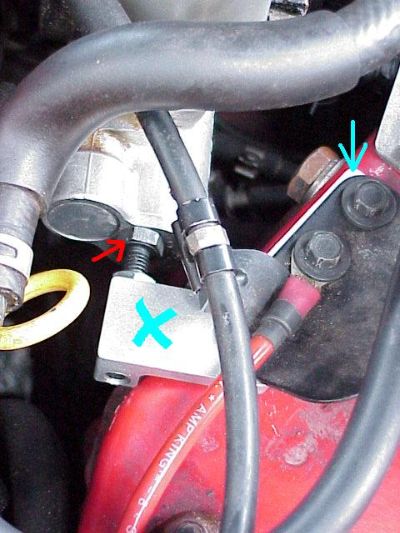 The brace keeps the firewall from flexing forward during hard brake pedal pressure. Since the master cylinder is mounted to the firewall, this noticably firms up the feel of the brake pedal, and puts more pressure in the brake lines instead where it belongs. The brace keeps the firewall from flexing forward during hard brake pedal pressure. Since the master cylinder is mounted to the firewall, this noticably firms up the feel of the brake pedal, and puts more pressure in the brake lines instead where it belongs.
Back to the big brakes. Here is a pic of the front passenger caliper and adapter, installed. The view is looking at the backside of the brake caliper from under the car. The green arrows are the original bolts and attachment points for the caliper. The red arrows show the new bolts and attachment points for the caliper. The yellow X's are on the body of the new aluminum caliper adapter. This pic also shows the unpainted rear view of the calipers. Removing the calipers just to paint them is a wasted effort. The calipers look great from the outside, and this side never shows during normal use.
 Bernie's kit comes with instructions. Since brakes are the single most important safety feature on car, follow all the recommended torque specifications for the mounting bolts. In other words, if you don't have a torque wrench, go buy one. Bernie's kit comes with instructions. Since brakes are the single most important safety feature on car, follow all the recommended torque specifications for the mounting bolts. In other words, if you don't have a torque wrench, go buy one.
Before
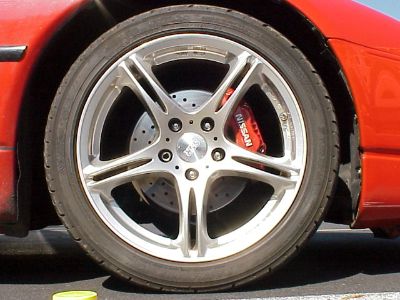 Wheels in front are SSR GT1's, 17 X 8". A minimum of 17" wheels are required for the bigger rotors, so the stock 16" wheels will not allow for the fit. Wheels in front are SSR GT1's, 17 X 8". A minimum of 17" wheels are required for the bigger rotors, so the stock 16" wheels will not allow for the fit.
After
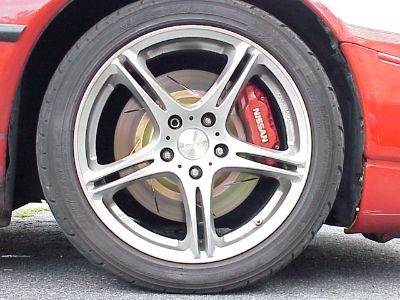 Notice the difference in the dark gap between the outer edge of the brake disc and the inner edge of the wheel rim in both pics. The larger disc fills the space behind the wheel much more than before. The red caliper is also more visible. Notice the difference in the dark gap between the outer edge of the brake disc and the inner edge of the wheel rim in both pics. The larger disc fills the space behind the wheel much more than before. The red caliper is also more visible.
The improvement in the brakes was dramatic and undeniable. I wasn't anticipating such a big change. The first time I hit the brakes, my passenger and I nearly snapped our necks against the shoulder belts. I think the improvement was in large part due to the new Hawk HPS High Performance Street brake pads that were installed on all four wheels. I had been using Axxis Metal Master pads. I've gotten feedback from a few folks who also noticed a big difference between those two brands. I would not recommend the Hawk "Blues" which are a racing pad, extremely abrasive, and will make short work of any rotors.
So all together, three new items were installed - the larger front rotors, new high performance brake pads, and the brace to shore up the master cylinder. For a street driven Z, good brake pads, stainless steel brake lines, and a synthetic high temperature brake fluid are good enough, unless you like to do some highly spirited driving over twisty, hilly roads. Since I like to track my Z on road courses such as Sebring and Watkins Glen, the bigger discs helped significantly reduce, but did not eliminate brake fade.
I noticed the shims were missing from all four brakes calipers. I purchased and installed all new OEM shims for the front and rear brakes and I recommend doing the same to keep disc chatter and squeal to a minimum. The factory service manual, the folks who sold me the rotors, as well as the folks who sold me the pads all recommended that I use synthetic brake grease between the mating surfaces of the shims and pads. This kept the brakes nice and quiet. Without the brake grease, I had a very loud squeal with the front brakes even with the new shims in place.
While pulling the pads to grease the shims, I noticed the rotors were cutting into the outer edge of the pad and leaving a "lip" of brake pad material behind, as shown below.
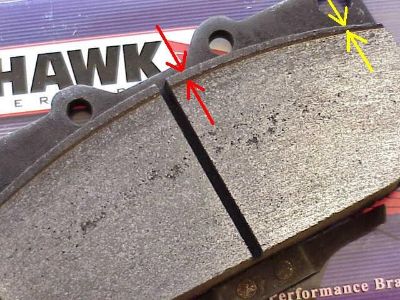 The pic shows that the width of the lip on the brake pad is greater near the center of the pad shown by the red arrows, and then gradually tapers toward the edges, shown by the yellow arrows. The pic shows that the width of the lip on the brake pad is greater near the center of the pad shown by the red arrows, and then gradually tapers toward the edges, shown by the yellow arrows.
This was because the "arc" of the stock caliper was curved to fit the stock rotor or disc which is two inches smaller in diameter. The lip will get deeper as the pad wears but I am told that this does not create a problem. I will post any long term follow-up.
| 